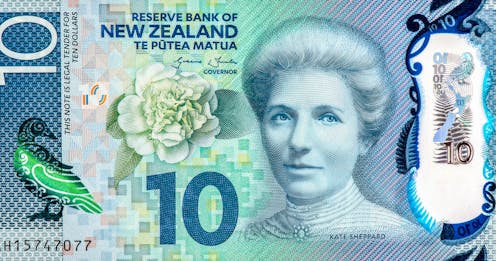On the money: Kate Sheppard and the making of a New Zealand feminist icon
- Written by Katie Pickles, Professor of History, University of Canterbury

In 1992 four New Zealand icons (and the queen) appeared on new banknotes. Part of creating national identity, these notable citizens were chosen to represent the pinnacles of achievement.
Āpirana Ngata, Edmund Hillary, Ernest Rutherford and Kate Sheppard — all in circulation so their acts and values can be admired, celebrated and emulated.
Collectively, the banknote icons signalled a bicultural nation that celebrates Māori knowledge and success, a place where women are equal and where it is possible to lead the world, including in science and exploration.
But while positioned on individual pedestals, these people were also part of citizenship-building that relied on team efforts.
Ngata was one of many talented members of the Young Māori Party. Hillary didn’t climb Everest alone. And Rutherford’s scientific breakthroughs resulted from collaborative work that stood “on the shoulders of giants”.
Cast in bronze
So what of Kate Sheppard’s position? A year after she graced the $10 note, she was put on another pedestal, literally. Unveiled in 1993, the national memorial provides a useful interpretation of the suffrage leader’s place in the collaborative women’s movement of the late 19th century.
The memorial’s Christchurch location, Sheppard’s name in its title and her central position cast in bronze all recognise her leadership. But the monument also recognises how, after the victory, she brought together the networks that had formed during the suffrage campaign.
Sheppard became the first president of the National Council of Women (NCW) in 1896, but flanking her in bronze are others central to the women’s movement.
Meri Te Tai Mangakāhia of Taitokerau requested the vote for women from the Kotahitanga parliament. Amey Daldy was a leader of Auckland’s Women’s Christian Temperance Union (WCTU) and Franchise League. Ada Wells of Christchurch worked for equal educational opportunities for girls and women. Harriet Morison of Dunedin was an advocate for working-class women and active in the Tailoresses’ Union. And Helen Nicol led the important women’s franchise campaign in Dunedin.
The monument also recognises the complex layers and themes of women’s suffrage, including the place of men such as MP Sir John Hall who played a vital part in the suffrage victory. Seven other prominent suffragists are also named. Smaller panels depict generic women going about their daily lives, all part of the wider movement.
An archetypal heroine?
So what makes Sheppard so iconic? As well as her role in a world-first episode in New Zealand history, I would argue Sheppard embodies many of the characteristics common to modern heroines globally.
Who else but Sheppard?
Sheppard is on the money, then, but who else might represent the heroic archetype? Waikato woman of mana and Kīngitanga leader Te Puea Hērangi is surely one, described by historian J.G.A. Pocock as possibly the most influential woman in New Zealand’s political history.
Te Puea was also a mother figure. A literal healer, she nursed her people back to health — especially after the smallpox epidemic of 1913 and the devastating 1918 influenza epidemic that killed a quarter of the population at Mangatāwhiri, leaving many orphans to be cared for.
Her motto is said to have been “work, eat, pray, work again”. Te Puea was called to help her people and was dedicated to leading their resurgence. In particular, her efforts secured the Kīngitanga movement. Part of her legacy as the most active leader of her generation was the building of Tūrangawaewae marae at Ngāruawāhia.
Like Sheppard, Te Puea’s health and welfare work included campaigns against alcohol and smoking. In the face of Pākehā resistance she built an impressive health facility at Tūrangawaewae. In 1951 she became the first patron of the Māori Women’s Welfare League.
Her activism included seeking compensation for land confiscation. An early peace warrior, she led a non-violent campaign against conscription during the first world war. Like Sheppard, she was part of an international network and well-connected around the Pacific.
Also like Sheppard, Te Puea was strategic and collaborated with many men. She launched Māui Pōmare’s political career and later collaborated with Āpirana Ngata. Well known in the Pākehā world as Princess Te Puea, in 1937 she was made a Commander of the Order of the British Empire.
In many ways, of course, Christchurch and Ngāruawāhia were worlds apart. While both women challenged the state, Sheppard represented a mainstream Pākehā establishment, whereas Te Puea pursued mana motuhake for her people. Yet, placed side by side and viewed through an early 21st-century lens, both are important heroines in history.
Both stand for citizens working together for the common good. Kate Sheppard might be on the money to represent women’s rights as a fundamental part of Aotearoa New Zealand. But, as her memorial suggests, it’s important we don’t see her as the only woman worthy of being on a pedestal.
Authors: Katie Pickles, Professor of History, University of Canterbury



